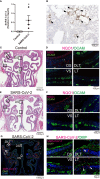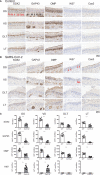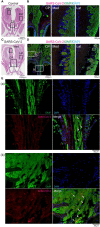Oral SARS-CoV-2 Inoculation Causes Nasal Viral Infection Leading to Olfactory Bulb Infection: An Experimental Study
- PMID: 35770069
- PMCID: PMC9234459
- DOI: 10.3389/fcimb.2022.924725
Oral SARS-CoV-2 Inoculation Causes Nasal Viral Infection Leading to Olfactory Bulb Infection: An Experimental Study
Abstract
Severe acute respiratory syndrome coronavirus 2 (SARS-CoV-2) infections can cause long-lasting anosmia, but the impact of SARS-CoV-2 infection, which can spread to the nasal cavity via the oral route, on the olfactory receptor neuron (ORN) lineage and olfactory bulb (OB) remains undetermined. Using Syrian hamsters, we explored whether oral SARS-CoV-2 inoculation can lead to nasal viral infection, examined how SARS-CoV-2 affects the ORN lineage by site, and investigated whether SARS-CoV-2 infection can spread to the OB and induce inflammation. On post-inoculation day 7, SARS-CoV-2 presence was confirmed in the lateral area (OCAM-positive) but not the nasal septum of NQO1-positive and OCAM-positive areas. The virus was observed partially infiltrating the olfactory epithelium, and ORN progenitor cells, immature ORNs, and mature ORNs were fewer than in controls. The virus was found in the olfactory nerve bundles to the OB, suggesting the nasal cavity as a route for SARS-CoV-2 brain infection. We demonstrated that transoral SARS-CoV-2 infection can spread from the nasal cavity to the central nervous system and the possibility of central olfactory dysfunction due to SARS-CoV-2 infection. The virus was localized at the infection site and could damage all ORN-lineage cells.
Keywords: COVID-19; SARS-CoV-2; olfactory bulb; olfactory dysfunction; olfactory epithelium; oral inoculation; zone.
Copyright © 2022 Ueha, Ito, Furukawa, Kitabatake, Ouji-Sageshima, Ueha, Koyama, Uranaka, Kondo and Yamasoba.
Conflict of interest statement
The authors declare that the research was conducted in the absence of any commercial or financial relationships that could be construed as a potential conflict of interest.
Figures





Similar articles
-
Evidence for the spread of SARS-CoV-2 and olfactory cell lineage impairment in close-contact infection Syrian hamster models.Front Cell Infect Microbiol. 2022 Oct 21;12:1019723. doi: 10.3389/fcimb.2022.1019723. eCollection 2022. Front Cell Infect Microbiol. 2022. PMID: 36339331 Free PMC article.
-
Severe Acute Respiratory Syndrome Coronavirus 2 Infects and Damages the Mature and Immature Olfactory Sensory Neurons of Hamsters.Clin Infect Dis. 2021 Jul 15;73(2):e503-e512. doi: 10.1093/cid/ciaa995. Clin Infect Dis. 2021. PMID: 32667973 Free PMC article.
-
Massive transient damage of the olfactory epithelium associated with infection of sustentacular cells by SARS-CoV-2 in golden Syrian hamsters.Brain Behav Immun. 2020 Oct;89:579-586. doi: 10.1016/j.bbi.2020.06.032. Epub 2020 Jul 3. Brain Behav Immun. 2020. PMID: 32629042 Free PMC article.
-
COVID-19 Anosmia: High Prevalence, Plural Neuropathogenic Mechanisms, and Scarce Neurotropism of SARS-CoV-2?Viruses. 2021 Nov 4;13(11):2225. doi: 10.3390/v13112225. Viruses. 2021. PMID: 34835030 Free PMC article. Review.
-
The Molecular Basis of Olfactory Dysfunction in COVID-19 and Long COVID.Lifestyle Genom. 2024;17(1):42-56. doi: 10.1159/000539292. Epub 2024 May 15. Lifestyle Genom. 2024. PMID: 38749402 Review.
Cited by
-
Neutrophils play a major role in the destruction of the olfactory epithelium during SARS-CoV-2 infection in hamsters.Cell Mol Life Sci. 2022 Dec 3;79(12):616. doi: 10.1007/s00018-022-04643-1. Cell Mol Life Sci. 2022. PMID: 36460750 Free PMC article.
-
Medicinal plants for the management of post-COVID-19 fatigue: A literature review on the role and mechanisms.J Tradit Complement Med. 2024 May 23;15(1):15-23. doi: 10.1016/j.jtcme.2024.05.006. eCollection 2025 Jan. J Tradit Complement Med. 2024. PMID: 39807273 Free PMC article. Review.
-
Nose-to-brain drug delivery: from bench to bedside.Transl Neurodegener. 2025 May 19;14(1):23. doi: 10.1186/s40035-025-00481-w. Transl Neurodegener. 2025. PMID: 40390100 Free PMC article. Review.
-
Evidence for the spread of SARS-CoV-2 and olfactory cell lineage impairment in close-contact infection Syrian hamster models.Front Cell Infect Microbiol. 2022 Oct 21;12:1019723. doi: 10.3389/fcimb.2022.1019723. eCollection 2022. Front Cell Infect Microbiol. 2022. PMID: 36339331 Free PMC article.
-
SARS-CoV-2-Related Olfactory Dysfunction: Autopsy Findings, Histopathology, and Evaluation of Viral RNA and ACE2 Expression in Olfactory Bulbs.Biomedicines. 2024 Apr 9;12(4):830. doi: 10.3390/biomedicines12040830. Biomedicines. 2024. PMID: 38672185 Free PMC article.
References
-
- Brann D. H., Tsukahara T., Weinreb C., Lipovsek M., Van den Berge K., Gong B., et al. . (2020). Non-Neuronal Expression of SARS-CoV-2 Entry Genes in the Olfactory System Suggests Mechanisms Underlying COVID-19-Associated Anosmia. Sci. Adv. 6 (31), eabc5801. doi: 10.1126/sciadv.abc5801 - DOI - PMC - PubMed
-
- Bryche B., St Albin A., Murri S., Lacote S., Pulido C., Ar Gouilh M., et al. . (2020). Massive Transient Damage of the Olfactory Epithelium Associated With Infection of Sustentacular Cells by SARS-CoV-2 in Golden Syrian Hamsters. Brain Behav. Immun. 89, 579–586. doi: 10.1016/j.bbi.2020.06.032 - DOI - PMC - PubMed
Publication types
MeSH terms
LinkOut - more resources
Full Text Sources
Medical
Miscellaneous

